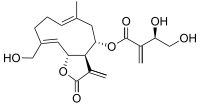Cnicin
 | |
| Names | |
|---|---|
| IUPAC name
[(1R,2S,4E,8Z,10S)-8-(hydroxymethyl)-4-methyl-13-methylidene-12-oxo-11 -oxabicyclo[8.3.0]trideca-4,8-dien-2-yl] (3S)-3,4-dihydroxy-2-methylidene-butanoate | |
| Identifiers | |
| 24394-09-0 | |
| ChEMBL | ChEMBL1257707 |
| ChemSpider | 4444781 |
| |
| Jmol-3D images | Image |
| PubChem | 5281435 |
| |
| Properties | |
| Molecular formula |
C20H26O7 |
| Molar mass | 378.42 g·mol−1 |
| Except where noted otherwise, data is given for materials in their standard state (at 25 °C (77 °F), 100 kPa) | |
| | |
| Infobox references | |
Cnicin is a sesquiterpene lactone, esterified with a substituted acrylic acid, and belonging to the germacranolide class of natural products. It is mainly found in Cnicus (Cnicus benedictus L. (Asteraceae)), and is present in spotted knapweed plants, where highest and lowest concentrations are found in the leaves (0.86-3.86% cnicin) and stems respectively.[1][2] Cnicin is used as a bitter tonic and the bitterness value is approximately 1,500.
References
- ↑ Olson, B. E. and Kelsey, R. G. (1997). "Effect of Centaurea maculosa on sheep rumen microbial activity and mass in vitro". J. Chem. Ecol. 23 (4): 1131–1144. doi:10.1023/B:JOEC.0000006391.88098.12.
- ↑ Providing Supplement, with or without PEG, to reduce the effects of cnicin and enhance grazing of spotted knapweed by sheep and cattle, Masters Thesis, M Cheeseman, Montana State University